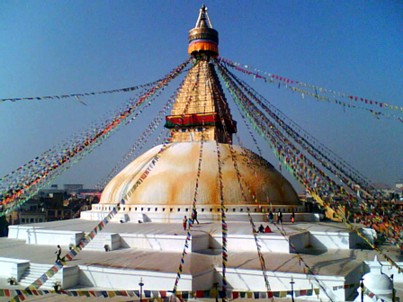Stupa: Difference between revisions
No edit summary |
|||
| Line 16: | Line 16: | ||
==Further Reading== | ==Further Reading== | ||
*''Stupa: Sacred Symbol of Enlightenment'', Crystal Mirror Vol. 12 (Dharma Publishing, 1997) | *''Stupa: Sacred Symbol of Enlightenment'', Crystal Mirror Vol. 12 (Dharma Publishing, 1997) | ||
*[[View: The Rigpa Journal]], July 2014, 'A Final Homage - Khandro Tsering Chödrön's Memorial Stupa' | |||
==Internal Links== | ==Internal Links== | ||
Revision as of 09:43, 29 August 2024

Stupa (Skt. stūpa; Tib. མཆོད་རྟེན་, chöten, Wyl. mchod rten) — a reliquary monument symbolizing the enlightened mind of the buddhas. They can vary in size and shape, but often have a wide square base, a rounded middle and a tall conical section at the top. They are found in the great monasteries and Buddhist centres of countries such as India, Tibet, Burma, Sri Lanka and Thailand. Originally, stupas were built to enshrine the relics of the Buddha and his most important disciples. As symbolic representation of the enlightened mind of the Buddha, they are of great significance and importance.
The Eight Stupas
1. The Lotus Blossom Stupa of the Buddha's Birth (Wyl. sku bltams mchod rten)[1]
The Lotus Blossom Stupa symbolizes the birth of Siddhartha, the man who would later be known as the Buddha. He was born in the Lumbini Garden at Kapilavastu in Northern India, in the sixth century BCE. The steps of the stupa are round and decorated with lotus petals.
2. The Enlightenment Stupa (Wyl. byang chub mchod rten)
After sitting in meditation for 49 days under a tree at Bodhgaya, Siddhartha attained enlightenment, and understood the true nature of all things. He realized that, like him, all beings without exception have the same potential for enlightenment, the ‘buddha nature’. The steps of the stupa are rectangular and undecorated.
3. The Stupa of Turning the Wheel of Dharma (Wyl. cho 'khor mchod rten)
This stupa represents the point at which the Buddha began to 'turn the wheel of the Dharma', to teach the path to enlightenment to others. Also known as the Stupa of Many Doorways, the steps are adorned with doorways symbolising the opening of the doors of the Dharma.
In the Deer Park at Sarnath, near Benares, the Buddha met up with the five ascetics who earlier had been his meditation companions on the banks of the Nairanjara River. They became his first disciples and received his first teachings.
4. The Great Miracle Stupa (Wyl. cho 'phrul gyi mchod rten)
This stupa commemorates the Buddha’s display of miracles at Shravasti, where he was challenged to demonstrate his realization. The Buddha responded by performing a different miracle every day for 15 days. Each of the four steps, in each of the four directions have central extensions.
5. The Stupa of the Descent from Tushita Heaven (Wyl. lha bab mchod rten)
The Buddha's mother, Mayadevi, was reborn in a celestial realm called the Tushita Heaven. To repay her kindness, the Buddha spent three months there and taught her the path to enlightenment.
This stupa represents the Buddha’s return from the celestial realms in order to continue teaching the people of northern India. Each side of the stupa has a stairway in the centre of the four steps.
6. The Stupa of Reconciliation (Wyl. dbyen bsdum mchod rten)
This stupa symbolizes the Buddha’s reuniting of his monastic followers after they had become divided by disagreement. The steps are octagonal with eight corners and eight sides.
7. The All-Victorious Stupa (Wyl. rnam rgyal mchod rten)
This stupa symbolizes the Buddha’s agreement to extend his life by three months, after one of his followers had pleaded with him not to pass away. The steps of the stupa are round.
8. The Parinirvana Stupa (Wyl. myang 'das mchod rten)
This stupa marks the Buddha’s passing into nirvana, a state of true peace which is beyond death.
With his final words, the Buddha urged his followers to be diligent in their efforts to attain enlightenment. Lying on his right side and in a state of profound meditation, he left the world and passed into nirvana. There are no steps in this stupa, the vase rests directly on the throne.
Notes
- ↑ Or the Sugata Stupa (Wyl. bde gshegs mchod rten).
Canonical Literature
Sutras
Teachings Given to the Rigpa Sangha
- Tulku Rigdzin Pema Rinpoche, Lerab Ling, 19 September 2012
- Tulku Rigdzin Pema Rinpoche, Lerab Ling, 25 September 2023
Further Reading
- Stupa: Sacred Symbol of Enlightenment, Crystal Mirror Vol. 12 (Dharma Publishing, 1997)
- View: The Rigpa Journal, July 2014, 'A Final Homage - Khandro Tsering Chödrön's Memorial Stupa'
Internal Links
External Links
- The Benefits of Building a Stupa, Offering Prostrations, Presenting Offerings, Circumambulating It, and Making Aspirations, by Chatral Sangye Dorje Rinpoche
- Stupa: Art and Architecture outline page at Himalayan Art Resources
- Stupas: Incalculable Sources of Blessing, A teaching by Tulku Sang-ngag Rinpoche
- Teaching on The Power of Stupas by Dzongsar Khyentse Rinpoche, Bariloche, Argentina, 2019
 The Dhāraṇī for Secret Relics
The Dhāraṇī for Secret Relics The Dhāraṇī for a Caitya
The Dhāraṇī for a Caitya The Verses on Circumambulating Shrines
The Verses on Circumambulating Shrines Verses for Prasenajit
Verses for Prasenajit